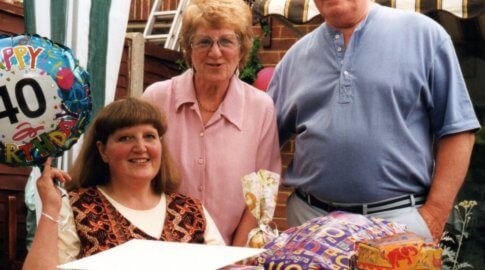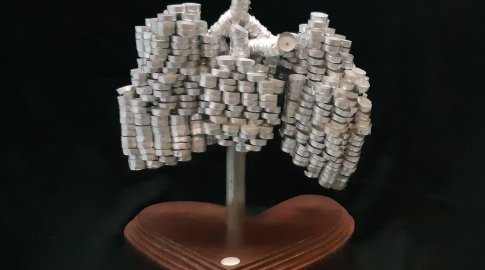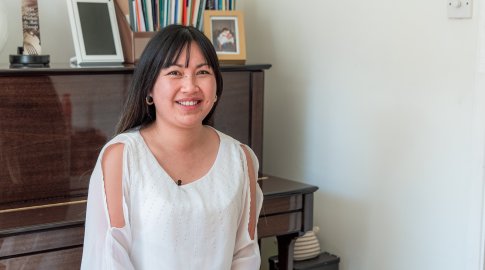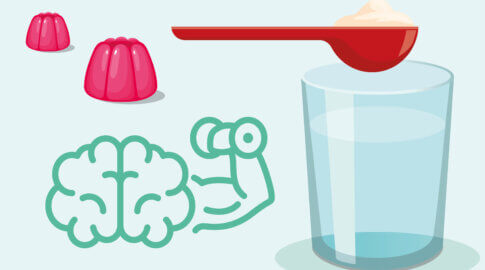“It’s a life-long condition, but it’s not always life-limiting”
Pulmonary hypertension affects everyone differently, and PHA UK member Sarah Pyett is keen to highlight that the condition can sometimes have positive outcomes. This is her story.

In July of 2013 I was in London to run the British 10k. In September of the same year, I returned to the city to attend a friend’s wedding. I clearly remember getting off the tube at Tower Hill station, walking up the steps to the street with my suitcase, and feeling a pressure in my chest when I reached the top. The feeling passed within a few seconds, I shrugged it off and carried on enjoying my weekend of celebrations.
Over the next month or so, I experienced that feeling of pressure more and more often. I’d get it when I walked up the stairs at home, when I got out of the car to walk into the supermarket, any time I went from a relatively relaxed state to exerting myself in the slightest.
One evening at home, I walked upstairs and sat down at the desk in my study. I remember feeling the pressure in my chest, followed by a dizziness, and I blacked out in the chair. I knew it was time to get seen by a doctor, so I took myself to A&E the next day.
After X-Ray’s, blood tests and a CT scan, they sent me home with heparin injections after suspecting a blood clot on my lung. When the symptoms didn’t disappear, I went to my GP who referred me to a cardiology team, and over the course of the next few months, I had multiple 24-hour and 7-day heart monitors, alongside more scans and blood tests. When the teams at my local hospital had exhausted every avenue, I was referred to the cardiology team at Papworth hospital in Cambridge.
During the time between referrals, I continued to experience chest pressure, and I passed out a few more times after climbing the stairs at home. These were my only real symptoms, I didn’t experience any of the other common symptoms such as breathlessness, fatigue or ankle swelling.
Finally getting answers
A few months later, I went to Papworth for a procedure to test the electrical pathways in my heart, and it was during this investigation that they discovered my arterial pressures were much higher than normal. I got referred to yet another team, but this time a team that I would come to know very well.
Over the course of two days in December 2014, I attended the Pulmonary Vascular Disease Unit at Papworth, and underwent blood tests, a 6-min walk test, pulmonary function tests, X-Rays, an ECG, echocardiogram, and a right heart catheterisation.
From the date I first took myself to A&E, it was 13 months until I finally got my diagnosis, Idiopathic Pulmonary Arterial Hypertension, the kind that has no underlying cause.
Whilst my lung function was good, the right side of my heart was enlarged and the walls were stretched thin. Fortunately, during my right heart catheterisation the team had tested my response to nitric oxide, and I was deemed ‘vasoreactive’. This meant that I was suitable for a type of medication called a vasodilator, which the doctors described to me as being like the very first rung on the long ladder of treatment options. They assured me this was a positive thing, despite the diagnosis I had just been handed.
The pharmacist prescribed me Nifedipine, and since I took that first tablet while still on the hospital ward in 2014, I have experienced absolutely no PH symptoms whatsoever.
Enjoying life with PH
Despite the doctors telling me not to Google the condition, that’s the way of the world these days, and I did research it when I was initially diagnosed. The life expectancy data that you see is frightening, and it did consume me for the first couple of months until I realised just how historical it was, and how many more successful treatments exist today.
When I went back to Papworth for my check-up six months after diagnosis, my test results showed that my arterial pressures were much lower, my lung function normal, and my heart had returned to the size and shape that it should be. This has continued to be the case at every check-up since. I am now seven years post-diagnosis, and doing really, really well. I even had extra staff wanting to witness my exercise test a couple of years ago, as they couldn’t believe how well I am.

I am very active day-to-day, I swim at least 1km most evenings, I try to get out walking as much as possible, and I’m a keen golfer. I’m not allowed to lift anything heavy due to the strain it could put on my heart, but aside from that I have no real restrictions in my day-to-day life. The only side effect I get from my medication is slight swelling/discoloration on my ankles and lower legs. It did bother me for a while initially, but I’ve learned to live with it now and it’s such a small price to pay for a healthy heart. Plus, there is always fake tan!
I’ve been able to continue to work full time, which is great. My two-day stay at Papworth actually came just one month into a new job, and my employer couldn’t have been any more supportive. I was office based prior to Covid, but am now based at home, with the occasional visit into the office.
My partner, Fiona, lives in beautiful North Wales. We met at a concert in 2014, before I was diagnosed, so she has known about my condition since day one. As a couple, we love travelling, anything to do with animals, and we absolutely love going to concerts.

My PH doesn’t hinder me when it comes to any of this, the only additional thing I have to do is declare my condition on my travel insurance to ensure I am covered abroad.
For anyone newly diagnosed, I would say to try to stay positive (as hard as it can be sometimes), and keep in mind that there are many, many different treatment options available to you. For so many, PH isn’t the sentence that it once was. Remember that Google is not your friend, but the PHA Facebook Group is. It’s full of other people going through the same as you, people who can give you advice, support, and just be there if you’re having a bad day and need to let off some steam.
I know I am a rare case, and I am incredibly lucky that my life with PH isn’t much different to life before PH, but I wanted to write this blog to show that PH can sometimes have positive outcomes. It’s a life-long condition, but it’s not always life-limiting.
If anyone would like to find me on Instagram, you can do so here















